A major challenge facing intrapreneurial teams is how to figure-out which specific value types are being created within new concepts and business models (particularly for sustainability business-innovation projects). It’s easy to focus on shiny new features, rather than the real value being proposed. This article helps you avoid this problem entirely by helping you understand all value types possible.
By the end of this article, you gain an understanding of over 130+ different value types and how they serve to meet the needs of: people, planet, purpose and progress perspectives.
Key Learnings From This Article
- Understand why you should suspend solution thinking and mindsets
- Uncover exactly what ‘sustainable business value’ is from multiple stakeholder perspectives
- Discover 130+ value types across the four stages of sustainable business & innovation
- Learn how to clearly articulate value propositions for sustainable innovation projects
Solution thinking mindset too early
It’s all too easy to focus on how amazing your solution is within your concept. Solution features are simple to articulate and explain to others when pitching new concepts and business models for funding because they are fully visible and tangible. Value on the other hand is more fluffy to think of.
Suspending solution thinking is particularly difficult for team members from R&D, engineering and agile development departments, because they are normally evaluated for their ability to implement new features and solutions during day-to-day work tasks. So they naturally form part of day-to-day operations.
Signs of solution-orientated mindsets can be found all around. You’ve probably heard solution-focused feedback particularly during the ideation process. Phrases along the lines of:
- ‘This concept just won’t work because we have no way to build it easily’
- ‘That’s too complicated for our current technology stack’
- ‘My brain isn’t wired for all this creative thinking’
- ‘In my experience that will be impossible to build’
- ‘We’ll never get the go ahead to digitalize like that’
- ‘That will cause problems when we hand over to our Agile teams’
- ‘Our core business is slow lifecycle, high margin, durable mechanical components, not digital and fancy AI’
- ‘How is that going to help me with my quarterly results and evaluation?’
- ‘It’s just too far away from what we do right now’
Typical signs of solution orientated culture and mindsets within innovation teams.
Impact of Early Solution Thinking on Innovation
Focusing on features, specifications, implementation challenges and final solutions early-on means innovation teams experience unnecessary barriers to innovation, for instance:
- Preventing divergent thinking during ideation rounds during the problem-fit phase.
- Pulling thinking and doing towards incrementalism grounded in feasibility barriers.
- Keeping concept propositions close to the core business.
- Preventing teams from coming-up with radical and disruptive ideas to test and (in)validate.
- Frustrating team members who want to explore many different ideas to solve problems
- Innovation process is applied sub-optimally.
- New concept and business model options are not explored fully.
- Creative thinking and mindsets gravitate towards ‘safe’ options.
- Team members don’t have fun through unrestricted creative thinking and imagining.
- Inability to clearly articulate the value they are creating for their customers, users and buyers.
By suspending solution thinking teams remain open to divergent thinking, creative thought and the potential for more radical and disruptive concepts to emerge. They key to doing this, is by understanding what value is and how you are bringing it to your stakeholders.
Focusing on the value is key
”Customers don’t care about your solution; they care about their problems.
Dave McClureEntrepreneur & Investor
Your customers, users and buyers simply don’t care about your new features and your solutions. They care about their problems being solved through the value you are creating for them.
Innovation teams need to be able to understand what specific types of value they are creating for their stakeholders and customers; rather than the solution features they are proposing.
As Warren Buffet once stated: “price is what you pay; value is what you get”. He didn’t frame it as, “price is what you pay, solutions features are what you get,” for good reason.
Thinking More Abstractly About Your Concepts
This means teams need to understand how to think more abstractly about proposed concepts, features and solution benefits. They must step-back from their concepts in order to see them from their customers’ point of view and they must be able to explain how the value (not features) solves their problem(s).
How do you go about understanding what type of value you are creating within your concepts and business models? The answer first lies within understanding the idea of value itself.
Activity (2 mins)
Before reading further, write down your own personal definition of value and compare it with the following definition.
Understanding what value is
What do we mean when we say we are creating value? Let’s start with a prominent definition.
Value is Described As:
The worth in monetary terms of technical, economic, service and social benefits a customer or company receives in exchange for the price it pays for a market offering (Anderson and Naurus, 1998).
Taking this definition, value consists of three core elements:
- Value is monetary (or other units)
- Value is net benefits (minus costs to obtain)
- Value is transactional (what is obtained in exchange)
Value is therefore something encompassing three core elements at the same time. It doesn’t simply focus on specific features of final solutions.
Below is a visualization of a customer value peak.
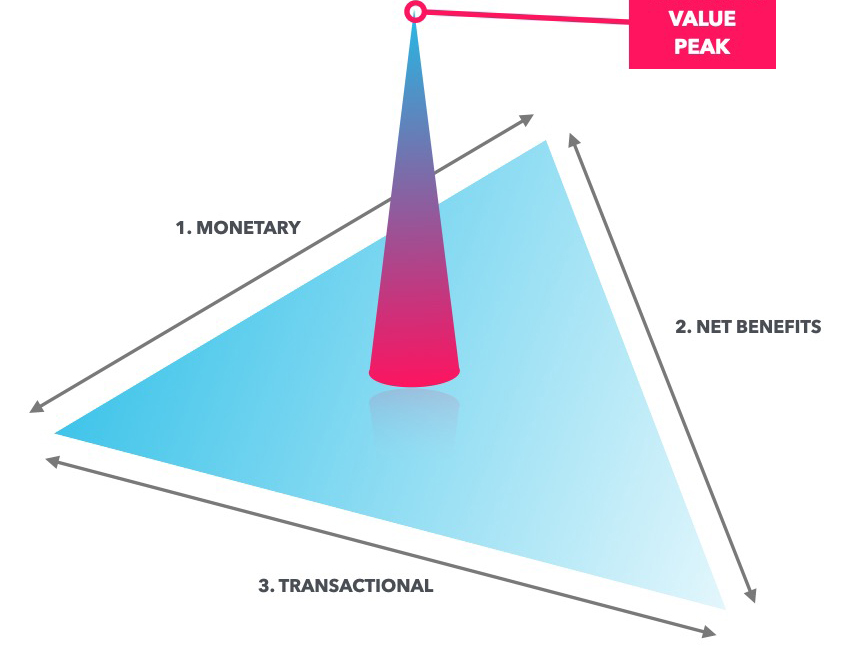
Visual model explaining what value is comprised of and what innovation seeks to find
Innovation seeks to systematically locate and create value peaks for customers and buyers by imagining and proposing new solutions and business models. A customer reaches intent to buy when the value peak is good (or high) enough to solve their unmet needs and/or problems.
We can think of innovation as a process to enable value seeing and seeking. It is designed to help teams navigate extreme uncertainty whilst validating creative ideas and supporting business models. Innovators apply specific tools, methods, processes and mindsets to help uncover new value peaks that deliver net benefits to your customers, users or buyers. Once conceptualized, they are made physical through prototyping and testing to (in)validate them with customers, users and buyers.
Value Landscape Example: COVID-19 Global Pandemic
The current pandemic has quickly changed the value landscape across markets, industries and sectors and countries as new needs and problems emerged over night, requiring new creative solutions and supporting business models. Organizations who were quick to explore and discover new shifting value peaks through the innovation process have been able to adapt to the emergent needs and ensure future survival and growth. The animated diagram below illustrates an accelerated shifting value landscape.
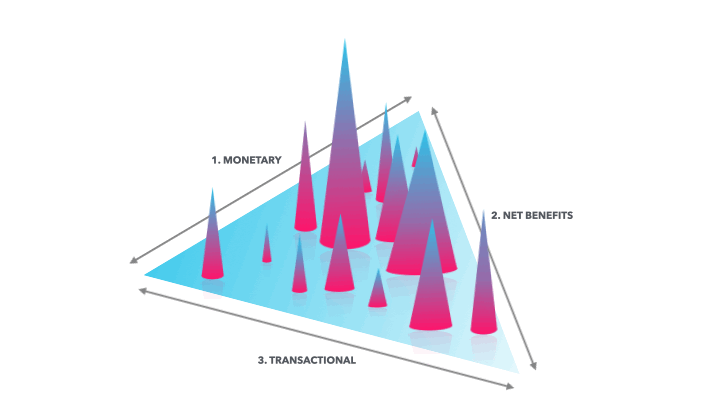
The ‘value landscape’ recently in turmoil and under drastic changes
Entire industries can be value-disrupted by external changes, whether from international pandemics, new emerging technologies, shifting consumer preferences or external environmental factors. Our job as innovators is to navigate and capitalize on these value shifts.
New Concepts, Business Models & Value Types
The idea of value is an abstraction that sits above proposed concepts, features and business models. Value can take many different forms, depending on who you are serving (individual customers, people, business, society, culture, environments, ecosystems, planet etc). It also depends on their specific needs and problems.
Value explains the combination of: monetary, net benefit and transactional elements of new concepts and business models. It is a way to explain how unmet needs, problems and issues can be solved. Value summarizes and articulates the monetary, net benefits and transactions more broadly than simply describing features. Customer care about the value, not the features.
Take a look at the diagram below to understand the different levels of abstraction of an innovation project. It shows how value abstraction exists above ideas, concepts and solution features.
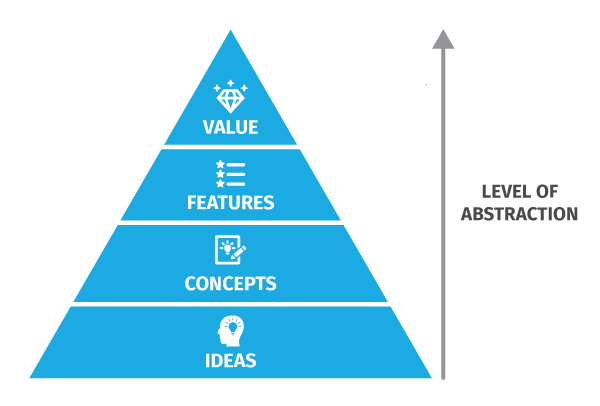
We need to consider the idea of value beyond ideas, concepts and features.
Innovation teams typically only focus on specific ideas, concepts and features. They merely explain these elements to investor panels, customers and buyers hoping they will get excited enough to reach willingness to buy. They miss-out the essential part, which is a clear explanation of how their proposed value solves their specific needs and problems within a value proposition statement.
How to Understand Your Value Types for Sustainability, Business & Innovation
The key to understanding value types is to get a broad sense of what they are and how they are different for each stage of the innovation process. To do this, let’s look at the modern innovation process, broken down into four key phases:
- People (social desirability)
- Planet (environmental necessity)
- Profit (economic viability)
- Progress (technological feasibility)
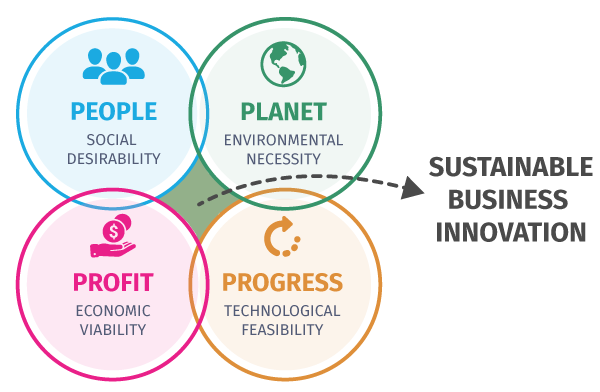
People, Planet, Profit & Progress dimensions beyond the dominant generalized: desirability, viability, feasibility model of old.
Moving Beyond the Traditional Innovation Process
The Sustainable Business Innovation approach above, moves beyond the typical customer desirability, business model viability and technical feasibility stages of old. In the outdated approach, there is little-to-no regard for the planet, environment, ecosystems, sustainability, grand challenges or wicked problems as part of the early problem exploration phase of the innovation process. As a result, planet issues, challenges problems and consequences often get missed out or are unconsidered as standard practice.
By considering planet and environmental value as integral of the modern innovation process, organizations can more easily develop new forms of value that impact beyond customer unmet needs and problems alone.
Framed in this way, organizations can address the 17 UN Sustainable Development Goals (UN SDG’s) at the strategic level by assessing and funding projects directly tackling such challenges with KPI’s and metrics designed to support their evaluation and progress.
130+ Value Types Wheel for Sustainable Business Innovation
In order to understand and articulate the exact value being created within innovation projects, the 130+ Value Types Wheel Tool can be used to support teams across the innovation process. It helps you understand many of the sustainable business value types possible.
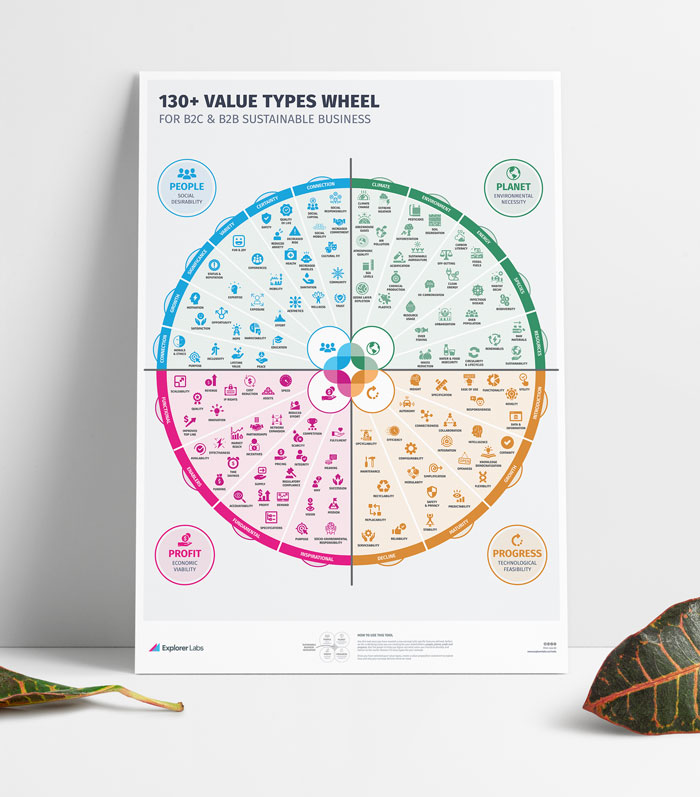
The 130+ Value Types Wheel to help innovation teams understand the value being created across People, Planet, Profit & Progress dimensions
Each phase of the innovation process is split into its own value quadrant. Within each value quadrant are sub-categories to help understand the different value types in more detail. Value types are then detailed under each sub-category as follows.
1) PEOPLE (Social Desirability)
Focusses on fundamental human value needs from personal and cultural dimensions:
- Connection
- Growth
- Significance
- Variety
- Certainty
- Connection
2) PLANET (Environmental Necessity)
Focusses on fundamental ecosystem value needs across core areas.
- Climate
- Environment
- Energy
- Species
- Resources
3) PROFIT (Economic Viability)
Focusses on business value needs in both B2B and B2C contexts.
- Functional
- Enablers
- Fundamental
- Inspirational
4) PROGRESS (Technological Feasibility)
Focusses on fundamental technology value needs across lifecycles.
- Introduction
- Growth
- Maturity
- Decline
Using the 130+ Sustainable Business Value Types Tool
The 130+ Value Types Tool can be easily deployed for both B2C and B2B sustainable business and innovation projects.
When to use it
The tool should be used once you have gone through your ideation rounds and have created a number of new concept cards to choose from.
- Once you have shortlisted your concepts, take some time to fully review the value types poster.
- If you are in the problem-fit phase, consider the value types in the People & Planet quadrants.
- If you are in the solution fit phase, consider the value types in the Planet and Profit quadrants.
- If you are in the market-fit phase, consider the value types in the Profit and Progress quadrants.
How to use it
Next, choose 3-6 value types that correspond to your new concept(s).
- Which types of value are you creating specifically?
- Which types of needs and problems does your concept contribute specific value towards?
TIP: You may want to select value from each of the quadrants, depending on the reach and complexity of your innovation project scope.
- Once you have selected your value types, your next task is to articulate your concept and value into a single value proposition statement:
Key takeaways
When running innovation projects, make sure to focus on the value you are creating from people, planet, profit and progress perspectives. Most innovation projects will create some form of value in each of the four phases.
Try to stay away from focusing on your solution features. You will miss out on opportunities for innovation if you just articulate how great your features are.
Instead, use the 130+ Value Types Wheel poster tool to help you figure out exactly what kind of value you intend to generate for your stakeholders and wider ecosystems. Try to embed UN Sustainable Development Goals into your innovation process and wider corporate strategy. This tool will help you explain exactly how you are contributing towards the grand challenges ahead of us.
Stick the poster up in your workshop, home or work office so that your team members are also familiar with the range of value types possible.
Figure out exactly what kind of value you’re creating
Download the 130+ Value Types poster here to supercharge the way you think about sustainable value creation across the innovation process.
Download the posterMike Pinder is a cross-industry business innovation expert & consultant, thought leader, author, lecturer & international keynote speaker on innovation. He’s driven by using innovation to leave the world a better place than we found it. Mike is a co-founder of Wicked Acceleration Labs (an industry-academia research lab aimed at tackling wicked problems), Member of Board of Advisors at Global Innovation Institute (GInI), & Honorary Practice Fellow at Imperial College London Business School.
Mike consults and leads across innovation strategy, Design Thinking, Lean Start-up, Business Model Innovation in both B2B and B2C, guiding c-level innovation strategy, innovation accelerator design, co-creation, capability programs, academic research, executive education (Exec Ed) university program design, intrapreneurship, digital transformation, sprints & more.
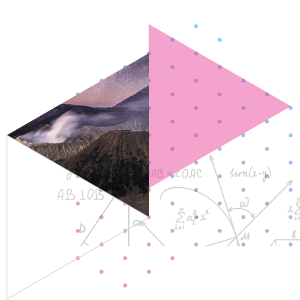
Let’s talk!
Reach out below
We’ll discuss your specific sustainable business-innovation challenges and what to do about them


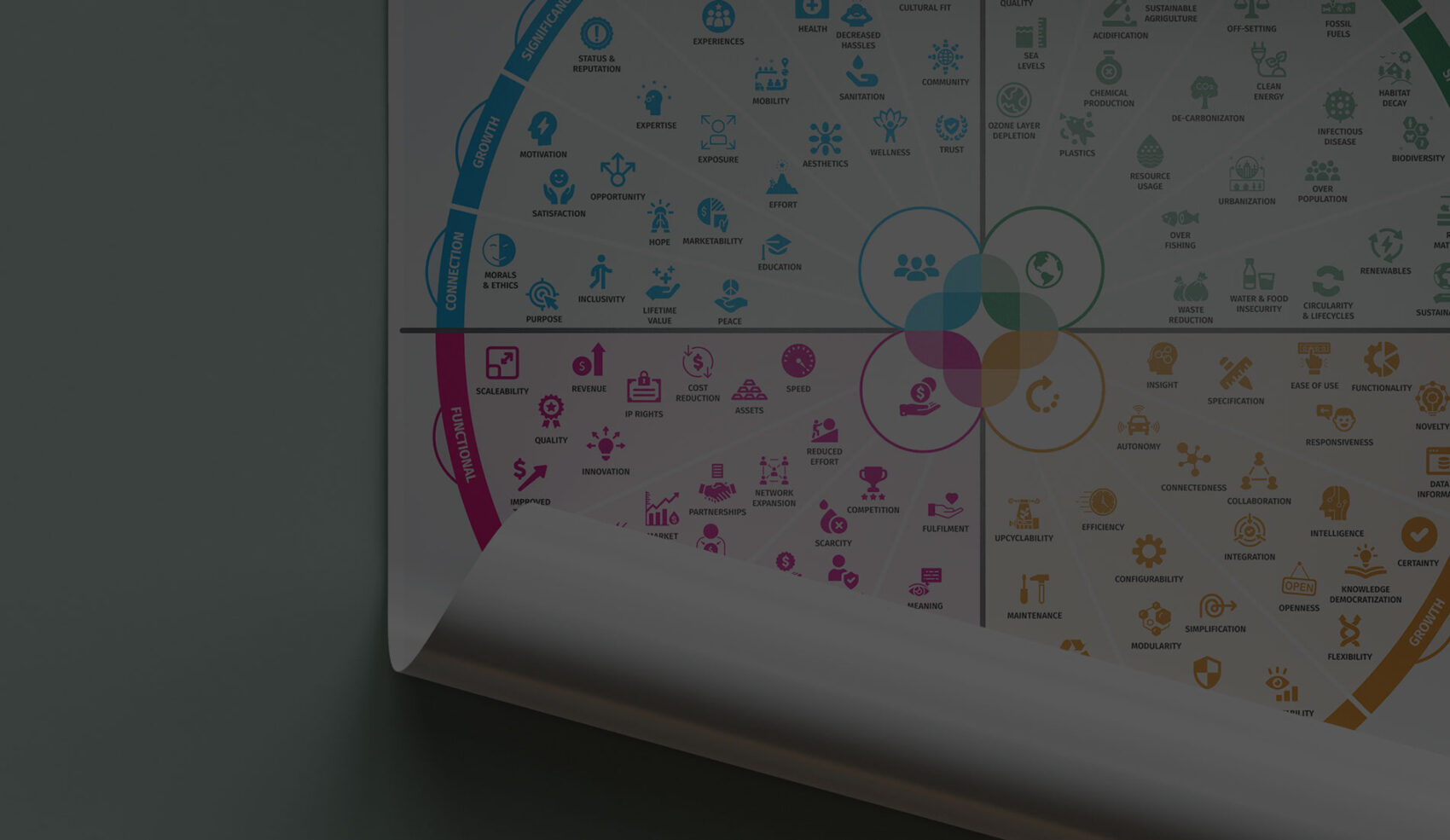


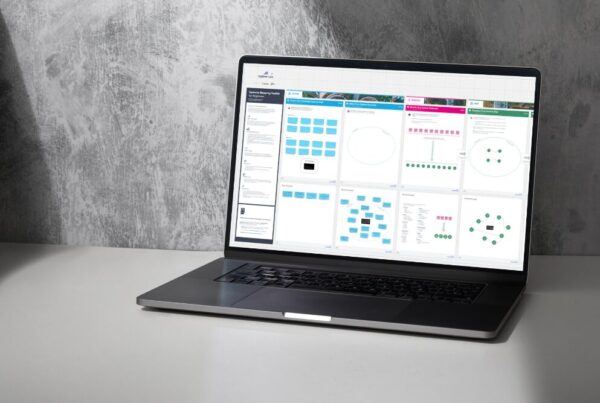
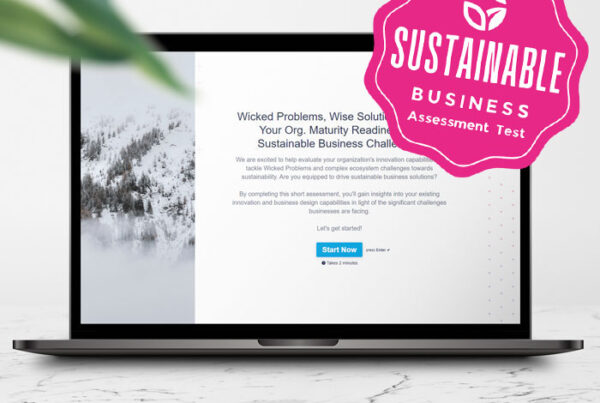

One Comment